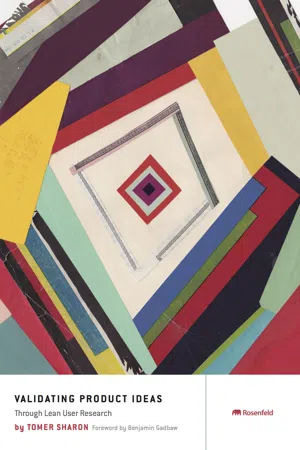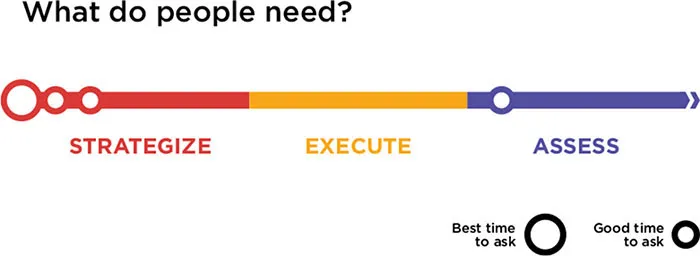
- 344 pages
- English
- ePUB (mobile friendly)
- Available on iOS & Android
eBook - ePub
About this book
Want to know what your users are thinking? If you’re a product manager or developer, this book will help you learn the techniques for finding the answers to your most burning questions about your customers. With step-by-step guidance, Validating Product Ideas shows you how to tackle the research to build the best possible product.
Frequently asked questions
Yes, you can cancel anytime from the Subscription tab in your account settings on the Perlego website. Your subscription will stay active until the end of your current billing period. Learn how to cancel your subscription.
No, books cannot be downloaded as external files, such as PDFs, for use outside of Perlego. However, you can download books within the Perlego app for offline reading on mobile or tablet. Learn more here.
Perlego offers two plans: Essential and Complete
- Essential is ideal for learners and professionals who enjoy exploring a wide range of subjects. Access the Essential Library with 800,000+ trusted titles and best-sellers across business, personal growth, and the humanities. Includes unlimited reading time and Standard Read Aloud voice.
- Complete: Perfect for advanced learners and researchers needing full, unrestricted access. Unlock 1.4M+ books across hundreds of subjects, including academic and specialized titles. The Complete Plan also includes advanced features like Premium Read Aloud and Research Assistant.
We are an online textbook subscription service, where you can get access to an entire online library for less than the price of a single book per month. With over 1 million books across 1000+ topics, we’ve got you covered! Learn more here.
Look out for the read-aloud symbol on your next book to see if you can listen to it. The read-aloud tool reads text aloud for you, highlighting the text as it is being read. You can pause it, speed it up and slow it down. Learn more here.
Yes! You can use the Perlego app on both iOS or Android devices to read anytime, anywhere — even offline. Perfect for commutes or when you’re on the go.
Please note we cannot support devices running on iOS 13 and Android 7 or earlier. Learn more about using the app.
Please note we cannot support devices running on iOS 13 and Android 7 or earlier. Learn more about using the app.
Yes, you can access Validating Product Ideas by Tomer Sharon in PDF and/or ePUB format, as well as other popular books in Betriebswirtschaft & Konsumverhalten. We have over one million books available in our catalogue for you to explore.
Information
CHAPTER 1

What Do People Need?
Why Is This Question Important?
When Should You Ask the Question?
Answering the Question with Experience Sampling
Why Experience Sampling Works
Other Questions Experience Sampling Helps Answer
How to Answer the Question
STEP 1: Define the scope and phrase the experience sampling question.
STEP 2: Find research participants.
STEP 3: Decide how long it will take participants to answer.
STEP 4: Decide how many data points you need.
STEP 5: Choose a medium to send and collect data.
STEP 6: Plan the analysis.
STEP 7: Set participant expectations.
STEP 8: Launch a pilot, then the study, and monitor responses.
STEP 9: Analyze data.
STEP 10: Generate bar charts.
STEP 11: Eyeball the data and identify themes.
Other Methods to Answer the Question
Experience Sampling Checklist
Until the moment Steve Jobs went on stage at Moscone Center in San Francisco in January 2007 and introduced the iPhone to the world, nobody knew they needed a smartphone. Nokia had recently sold their one-billionth phone, and it seemed people were generally satisfied with their phones. During the seven months that passed from the time Jobs held the first iPhone in his hands onstage until Apple began shipping iPhones to the masses, there was a bombardment of TV commercials in the U.S. that took a (successful) stab at creating the need.
Today, many people consider their smartphone (whether an iPhone, Android, or other) as an integral extension of their body. They don’t leave home without it. If they do, they go back and retrieve it. The reason is because they need it. This day and age, smartphones solve problems people have, save time people can never get back, and meet oh-so-many human needs. Yes, smartphones also turn some people into anti-social creatures, but that’s for a different book.
Many products are developed based on a hunch, a judgment call, incomplete information, or faith-based hallucinations. Only after they fail miserably do developers ask themselves why. In most cases, the answer is that the product does not meet a real user need or solve a problem people really care about. This chapter walks you through one straightforward technique for uncovering user needs, answering that vital question “What do people need?”
Why Is This Question Important?
“What do people need?” is a critical question to ask when you build products. Wasting your life’s savings and your investors’ money, risking your reputation, making false promises to employees and potential partners, and trashing months of work you can never get back is a shame. It’s also a shame to find out you were completely delusional when you thought that everyone needed the product you were working on.
The question is important because of the risk it entails. Many product development teams tend to ask themselves if they can build a product. The answer in most cases is, yes they can. When you realize the importance of first finding out what humans need, then you start asking yourself if you should build a product, rather than if you can.
When Should You Ask the Question?
“What do people need?” is probably the most important question a product development team will ask itself. Ninety-five percent of founders and product managers interviewed for this book did ask themselves this question. The timing of asking (or rather answering) this question is key because although needs are relatively stable, it’s worth being aware that users may not need “it” (whatever “it” may be) in six months’ time. The market might also affect needs—for example, legislation changes, entrance of other products to the market, etc.
That said, there are two great times to ask the question: somewhere in the beginning of strategizing your product, and after launching it during the assessment phase (see Figure 1.1).
• When you strategize, you try to figure out a lot of things about the need for your product, who your target audience is, and what your audience wants. Attaining this knowledge and wisdom will serve you well during the execution phase. Discovering user needs will help you figure out how the product should be built, because it will generate evidence, validation, and invalidation for various product features.
• During the assessment phase, your users use the product, and you can learn whether or not your product meets their real needs. Beware though. If this is the first time you study your audience’s needs, you might find and learn things that will be very hard and costly to fix. The best time to answer the question is prior to execution. However, it is never too late or an inappropriate time to ask the question. The sooner you realize you need an evidence-based answer, the better.

FIGURE 1.1
When is a good time to ask “What do people need?” The big circle represents the best time, while the smaller ones indicate other times recommended for asking the question.
When is a good time to ask “What do people need?” The big circle represents the best time, while the smaller ones indicate other times recommended for asking the question.
Answering the Question with Experience Sampling
Experience sampling is a strategic research technique that answers a high-level business (or roadmap) question rather than evaluating a design or product that already exists. Experience sampling is good for uncovering unmet needs, which will lead to generating great ideas for new products and for validating (or invalidating) ideas you already have.
In an experience sampling study, research participants are interrupted several times a day or week to note their experience in real time. The idea is based on what was called a pager study in the 1950s. The essence of the 1950s version of experience sampling was the use of pagers or other signaling devices to trigger involvement in the research study.
The key to experience sampling is asking the same question over and over again at random times during the day or week. This cadence and repetition strengthens your finding’s validity and allows you to identify patterns, like participants reporting greater satisfaction right after completing certain tasks. For example, you might ask people what annoyed them recently. Imagine if you ask that question five times a day for a period of five days and 100 people participate in your research. This means you will potentially collect 2,500 data points. That can be turned into a large, useful body of knowledge.
Why Experience Sampling Works
Experience sampling is an effective user research technique that has the following benefits:
• Offers insights about user needs: It gives you a glimpse into users’ lives and their realities and uncovers their objective needs.
• Provides evidence-based feature generation: The results can be transformed easily into product features because they provide a combination of qualitative and quantitative data about very ...
Table of contents
- Cover Page
- Title Page
- Copyright Page
- Dedication Page
- How to Use This Book
- Frequently Asked Questions
- Contents
- Foreword
- Introduction
- CHAPTER 1. What Do People Need?
- CHAPTER 2. Who Are the Users?
- CHAPTER 3. How Do People Currently Solve a Problem?
- CHAPTER 4. What Is the User’s Workflow?
- CHAPTER 5. Do People Want the Product?
- CHAPTER 6. Can People Use the Product?
- CHAPTER 7. Which Design Generates Better Results?
- CHAPTER 8. How Do People Find Stuff?
- CHAPTER 9. How to Find Participants for Research?
- Shake, Rattle, and Roll
- Index
- Acknowledgments
- About the Author
- Footnotes